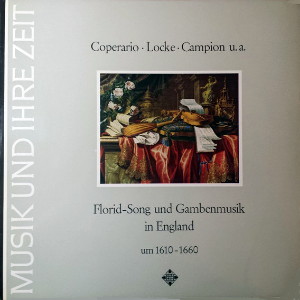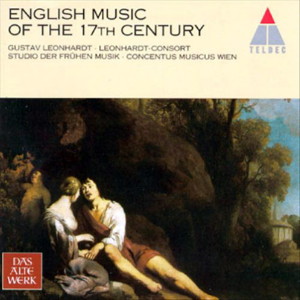 |
1 LP -
SAWT 9472-A - (p) 1965
|

|
| 2 CD -
4509-97942-2 - (c) 1995 |
|
Florid-Song und
Gambenmusik in England um 1610-1660
|
|
|
|
|
|
|
|
|
|
- Giovanni Coperario (John
Cooper) (c1575-1626) - My joy is
dead - (Mezzosopran, Countertenor,
Gambe und Laute)
|
SdFM
|
|
4' 18" |
A1 |
| - Giovanni Coperario (John
Cooper) - Fantasia für
drei Violen da gamba |
CMW |
|
--' --" |
A2 |
- Tobias Hume (?-1645) -
Tobacco - (Bariton und Gambe)
|
SdFM |
|
1' 23" |
A3 |
| - Orlando Gibbons
(1583-1625) - Fantasia für drei Violen da
gamba |
CMW |
|
2' 14" |
A4 |
| - Thomas Weelkes
(1576-1623) - Cease sorrows now - (Mezzosopran,
Tenor und Gambe) |
SdFM |
|
3' 12" |
A5 |
| - John Ward (1571-1638) -
Fantasia für vier Violen da gamba |
CMW |
|
3' 36" |
A6 |
- John Wilson (1595-1674)
- Stay o stay, why dont thou fly me - (Tenor
und Orgel)
|
SdFM |
|
1' 27" |
A7 |
| - John Wilson - Beauty
which alla men admire - (Tenor und
Orgel) |
SdFM |
|
1' 01" |
A8 |
- John Hingston (?-1683)
- Fantasia for one Cornet, Sagbutt with ge
Organ - (Ouvertüre) · Almand · Ayre
|
SdFM |
|
4' 28" |
A9 |
| - Thomas Campion
(1567-1620) - Come, you pretty false-eyed
wanton - (Countertenor, Laute und
Orgel) |
SdFM |
|
2' 42" |
B1 |
| - Anonymus - Deerest love
- (Tenor und Laute) |
SdFM |
|
2' 05" |
B2 |
| - Mathew Locke (1630-1677)
- Consort für vier Violen da gamba - (Fantasia
· Courante · Ayre · Sarabanda) |
CMW |
|
8' 18" |
B3 |
| - Anonymus - Nothyng on
earth - (Mezzosopran und Laute) |
SdFM |
|
3' 41" |
B4 |
| - Thomas Lupo
(c.1585-1645?) - Fantasia für drei Violen
da gamba |
CMW |
|
2' 05" |
B5 |
| - Robert Johnson
(c.1580-1634) - Care-charming sleep - (Countertenor
und Orgel) |
SdFM |
|
4' 43" |
B6 |
|
|
|
|
|
| STUDIO
DER FRÜHEN MUSIK |
CONCENTUS
MUSICUS, Wien |
|
| -
Andrea von Ramm, Mezzosoprano und
Orgel |
-
Alice Harnoncourt, Pardessus de
Viole |
|
| -
William Cobb, Tenor |
-
Nikolaus Harnoncourt, Diskant-
und Tenor-Viola da gamba |
|
| -
Sterling Jones, Gambe |
-
Elli Kubizek, Baß-Viola da gamba |
|
| -
Thomas Binkley, Laute |
-
Hermann Höbarth, Baß-Viola da
gamba |
|
| -
Grayston Bargess, Countertenor |
|
|
-
Nigel Rogers, Tenor
|
|
|
-
Karl Heinz Klein, Bariton
|
|
|
-
Dom Snithers, Zink
|
|
|
| -
Franz Eder, Posaune |
|
|
-
Viktor Lukas, Orgel
|
|
|
|
Luogo
e data di registrazione
|
- AEG-Studio,
München (Germania) - 15/16 & 18/19
giugno 1965 - (Studio der Frühen Musik)
- Palais Schönburg, Vienna (Austria) - 1
& 2 dicembre 1964 - (Concentus Musicus
Wien) |
|
Registrazione
live / studio
|
| studio |
Producer
/ Engineer
|
-
|
Prima Edizione CD
|
Teldec -
4509-97942-2 - (2 cd) - 67' 04" + 72' 20"
- (c) 1995 - ADD
|
Prima
Edizione LP
|
Telefunken "Das
Alte Werk" - SAWT 9472-A - (1 lp) - --'
--"
- (p) 1965
|
Note
|
Il
secondo brano della facciata (A2),
Coperario: Fantasia für
drei Violen da gamba, inspeigabilmente
non è stato riversato nell'edizione in
CD.
L'edizione in CD contiene anche altre
musiche interpretate dal Leonhardt
Consort.
|
|
|
Notes
|
The florid songs is
preserved in only about two dozen
manuscripts of the first half of the
17th century. The songs fall into two
main groups, those originally written
in a simple form to which ornamental
florid passages were added (Thomas
Campion, "Come you pretty") and those
composed originally in a florid form
("Nothing on earth"). Some were
written for Theatrical productions
"Care charming sleep" in which case
they would have been sung by actors on
the stage. In all of these remarkable
songs the ornaments are written out,
not improvised. A few ornamental signs
are employed in the original notation,
including a slanting line to indicate
a long slide (glissando) usually down
a fifth or octave. Equally remarkable
are the songs of John Wilson
(1595-1674), the most gifted English
song writer between John Dowland and
Henry Purcell. He was a lutenist and a
countertenor as well as a busy theatre
composer. Particularly remarkable are
the harmonies of his "Beauty which all
men admire" employing a stepwise
harmonie sequence. Thomas Weelkes
beautiful lament "Cease sorrows now"
is one of several English pieces to
employ extended chromatic scale
passages as an expression of grief.
The remarkable thing about the
"Fantasia" of Hingston is ist
instrumentation. Hingston, a composer
of organ and viol music (pupil of
Gibbons), indicated the
instrumentation: cornet, sackbutts and
organ.
Thomas Binkley
In the first centuries of western
music, indeed until well into the 17th
century, instrumentation played a very
subsidiary role from the composer's
point of view. The musical substance
was largely independent of its
realization in sound. The performers
had abundant possibilities for
adapting the works to the
circumstances of the moment, naturally
within the scope of generally accepted
rules, for it was they who first
decided what instruments to use, as
well as what was to be performed
vocally and what instrumentally. The
English composers (during the reign of
Elizabeth I) were the forst to give
explicit instructions themselves as to
the instrumentations of their works. A
particular predelictions for subtle
and ingenious sounds had existed in
England from the very earliest time,
and gentle instruments like the lute
and the viol were especially
cultivated here for centuries, more
than in any country on the continent.
Since every fairly educated person
could play an instrument, practical
music-making was cultivated in nearly
all the citizens' houses: every
self-respecting family possessed a
chest of viols of all sizes, and lutes
hung in the barbers' shops, with which
the customers could pass the time
while waiting. The compositions for
these instruments were intended in the
first place for the players
themselves; they were performed in
small rooms, in which all the finer
features of the instruments made
themselves fully felt. For this reason
the loud and extrovert violin, which
had long supplanted the viola da gamba
in Italy, was not able to assert
itself so quickly in England.
Thus, in the course of a hundred
years, there arose here a unique and
rich repertoire of music for two to
seven viols of all sizes. The
"abstract" tone of these instruments,
highly expressive in the finest
nuances, and their abiliy to blend
into a homogeneous whole on the one
hand while allowing a clear definition
of every line on the other, inspired
the composers to their finely written
yet boldly constructed fantasias and
stylized dance movements. They did not
have to write in an "easily
understandable" manner, since they
were dealing with an extremely
sensitive public.
In their form, these fantasias for
viols are inspired by the Italian
"canzoni di sonare" and the madrigals.
In alternations of homophonic and
polyphonic sections and slow and quick
passages, the seeds of a sonata form
in several movements are already sown.
Everything happens in the most
concentrated, concise form. The newest
achievements of Italian music must
have been taken up whith tremendous
eagerness, but they have been treated
in an unmistakably English manner, the
English instrumental works of this
period sounding far more mature than
the youthful and bizarre Italian
sonatas of the beginning baroque era.
Coperario (Cooper), an Englishman who
spent some years studyng in Italy,
Gibbons, Lupo and Ward were among the
most famous English composers of their
time (Coperario and Gibbons held
important posts in the music of the
court.) Their works became widely
known through a large number of
copies. Each of them wrote numerous
fantasias for a consort of viols.
Matthew Locke was a flamboyant,
self-willed personality. His genius
was greatly admired by his
contemporarye, and he was Composer in
Ordinary to the King from 1660 onward.
although he travelled widely in
Europe, he found no music equal to
that of England. In his full-blooded
mode of expression he wrote: "...to
those who must decry everything
produced by their fellow-countrymen...
ist must be said... that nowhere have
I seen any music that is worthy of
being copied by an Englishman... ." In
Locke's Suite for Four Violas da Gamba
we find a bold Fantasia (in the old
sense) as a prelude. The dance
movements that follow were not
intended for dancing to: the form and
the rhythm of the dances have been
used as the basis of purely
instrumental movements.
|
|
Nikolaus
Harnoncourt (1929-2016)
|

|

|
|